
Puff pastry brioche
Ingredients
Dough:
- 500 g T55 flour
- 1 packet of dry baker's yeast (5g) or 15g of fresh yeast
- 75 g sugar
- 5 g salt
- 115 g egg
- 265 g milk
- 75 g soft butter
Then:
- 175 g soft butter with 82% fat content
Instructions
- Pour all the ingredients for the dough except the butter into the bowl of your food processor fitted with the hook.
- Mix for at least 10 minutes. The dough is very soft.
- Add the 75g of butter then mix again until it is perfectly incorporated.
- Put a film on the contact and let it grow one night in the refrigerator.
- The next day the dough is perfect and has grown well.
- This time take the 175g of 82% butter. Just look in the shelves, you will find it. It is often an AOP Charentes Poitou butter. Flour it.
- Leave it at room temperature for 5-10 minutes (unless it’s hot) then tap it with the rolling pin to soften it, without heating it. Shape it into a 16cm square. You can also put it in a 16cm frame for ease.
- Take the dough out of the fridge and flour it. Place it on the work surface and press it down to release the gas.
- Roll out the dough into a 32cm x 16cm rectangle. Place the butter (still fresh) in the center.
- Join the edges to cover the butter.
- Roll out the dough into a long rectangle with parallel edges.
- Trim the end for a clean edge. Keep the scraps.
- Fold the dough over to meet the two ends.
- Then fold in half again. You did a double turn.
- Let cool for 15 minutes. That’s all. Turn the dough 90° and roll out into a new rectangle.
- Trim the ends and fold this time in thirds.
- You can also incise the fold.
- Roll out the dough this time into a 30x40cm rectangle. Trim the edges. You can now gather all the scraps together to push into a small pan and then bake. You will have a brioche, not very beautiful and less rich, but nevertheless delicious!
- Cut the dough into 3 pieces.
- Lay the three strips of dough on top of each other.
- Then roll them up together.
- Place in a greased baking pan. You can pull the top edge of each strip to slide them under the dough.
- Let it grow for 1 to 1.5 hours so that it swells well. Brush the gold onto the smooth edges of the dough.
- Bake for 1 hour and 10 minutes in a preheated oven at 150°C in rotating heat mode. As soon as the brioche comes out of the oven, brush syrup over the entire surface to make it shine.
- To be enjoyed hot, warm or at room temperature. Delicious plain or with a good jam!
Nutrition

As you may know, I have just finished writing my 6th book, which will be published by Flammarion on November 18th and which marks my real return to the field of pastry, even if there was some in “Végéterrien” and in “Je fais mon chocolat maison”. I’ve been away from the blog for a while, but only to come back to it. This time I’m offering you my recipe for puff pastry brioche, which is really not that complicated to make at home. But above all the result is really delicious and buttery. With a simple jam, it is the perfect snack or breakfast!
Recette pour une grosse BRIOCHE FEUILLETÉE :
Dough:
- 500g of T55 flour
- 1 packet of dehydrated baker’s yeast (5g) or 15g of fresh yeast
- 75g of sugar
- 5g of salt
- 115g of egg
- 265g of milk
- 75g of soft butter
Then:
- 175g of soft butter with 82% fat content
Gilding :
- 1 egg
- 2 tablespoons of milk
Instructions :
Pour all the ingredients for the dough except the butter into the bowl of your food processor fitted with the hook.

Mix for at least 10 minutes. The dough is very soft.

Add the 75g of butter then mix again until it is perfectly incorporated.
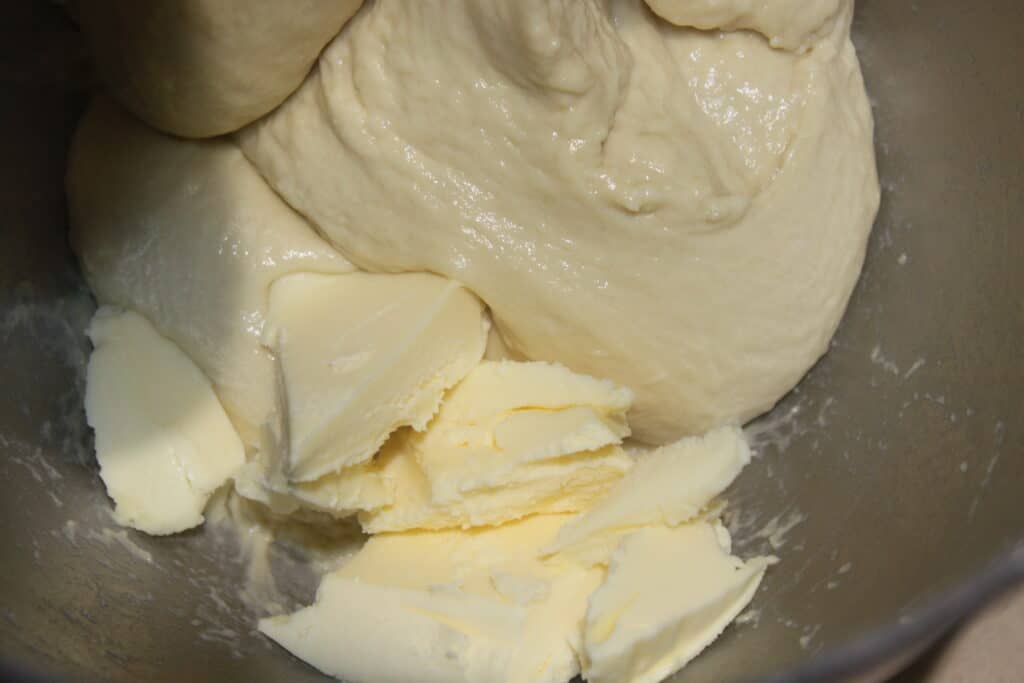


Put a film on the contact and let it grow one night in the refrigerator.

The next day the dough is perfect and has grown well.

This time take the 175g of 82% butter. Just look in the shelves, you will find it. It is often an AOP Charentes Poitou butter. Flour it.

Leave it at room temperature for 5-10 minutes (unless it’s hot) then tap it with the rolling pin to soften it, without heating it. Shape it into a 16cm square. You can also put it in a 16cm frame for ease.

Take the dough out of the fridge and flour it. Place it on the work surface and press it down to release the gas.

Roll out the dough into a 32cm x 16cm rectangle. Place the butter (still fresh) in the center.

Join the edges to cover the butter.
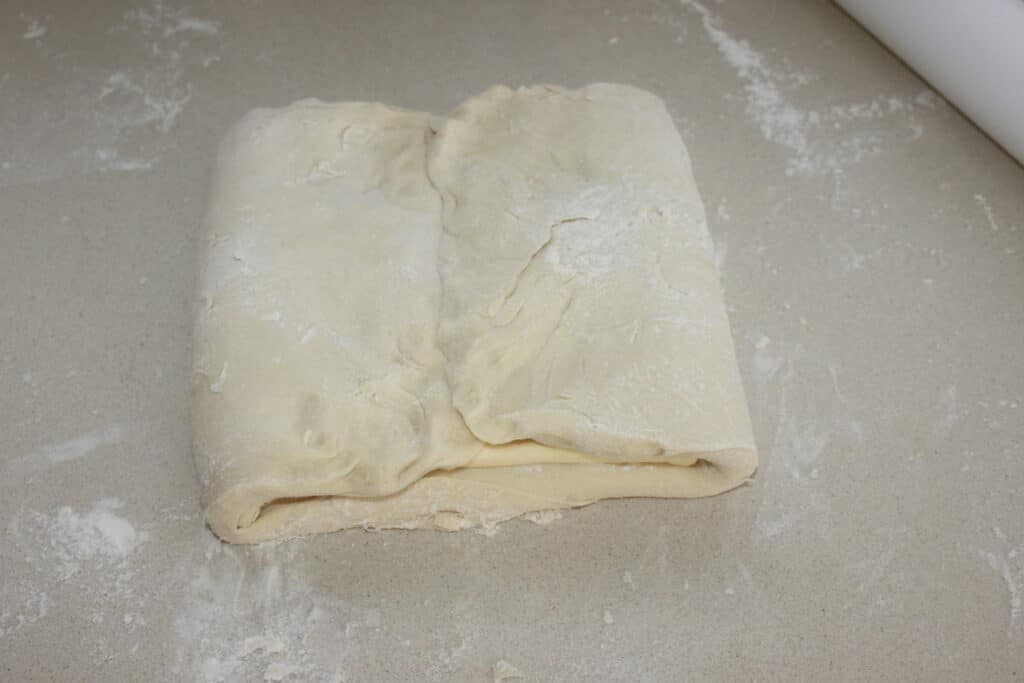
Roll out the dough into a long rectangle with parallel edges.
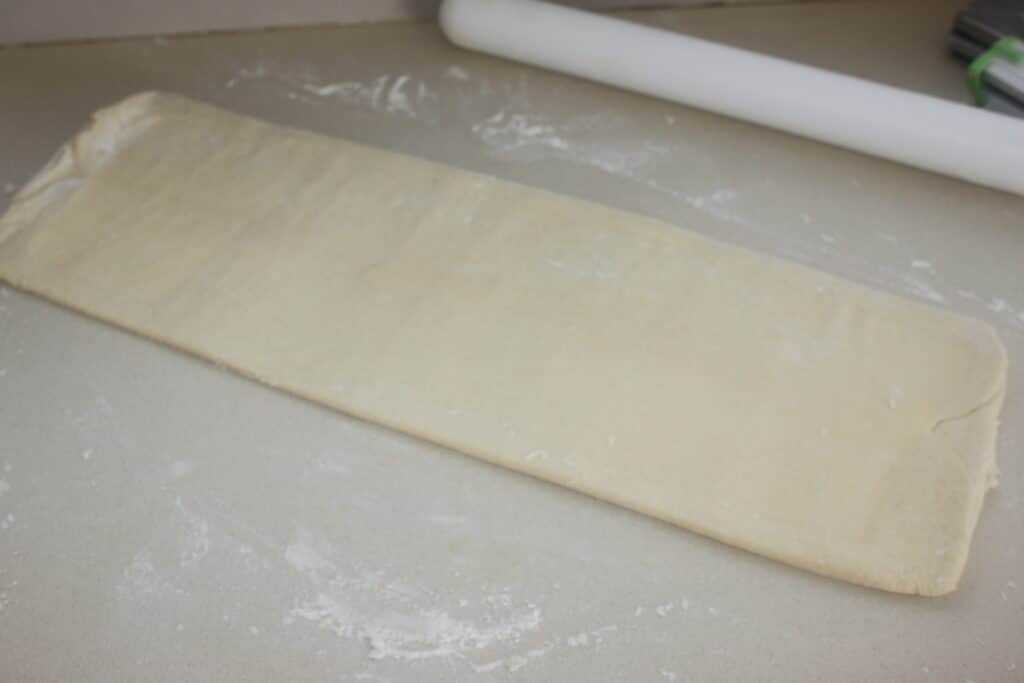
Trim the end for a clean edge. Keep the scraps.
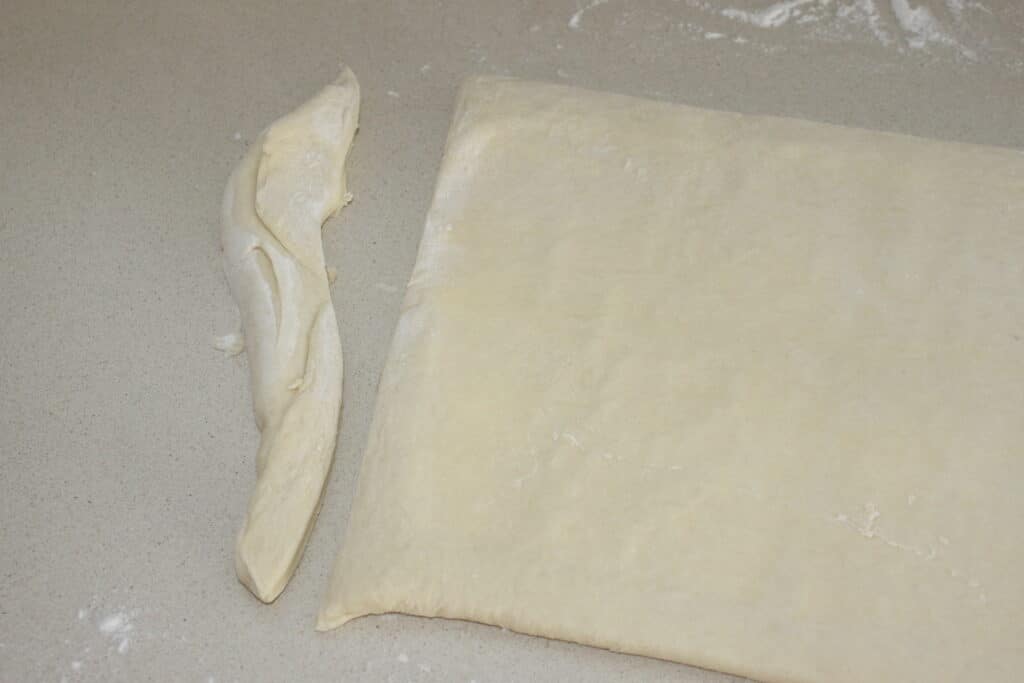
Fold the dough over to meet the two ends.
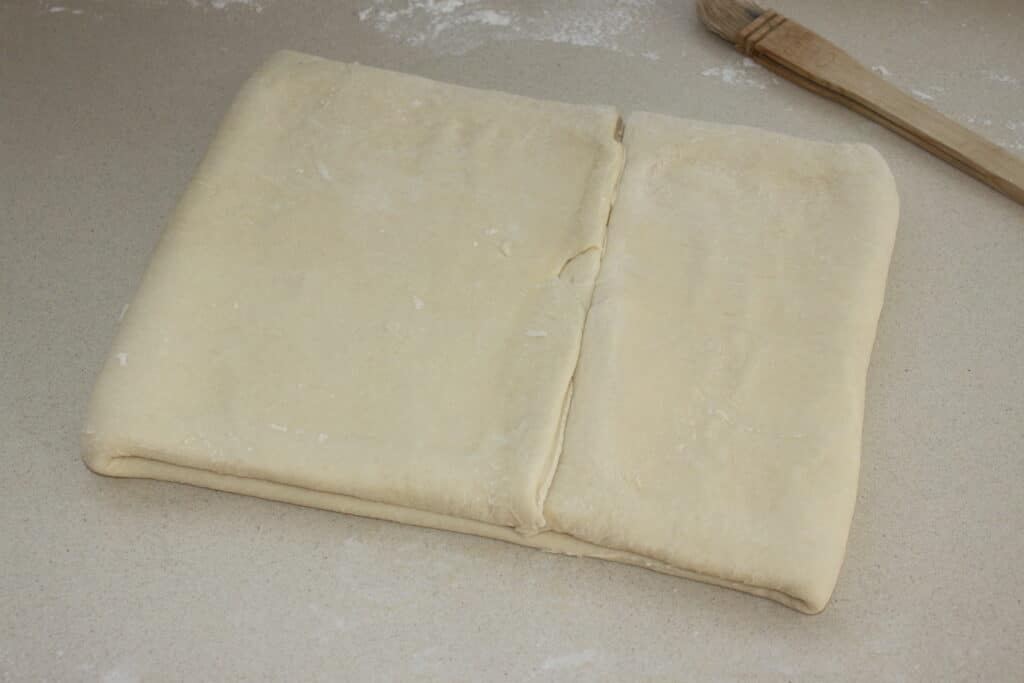
Then fold in half again. You did a double turn.
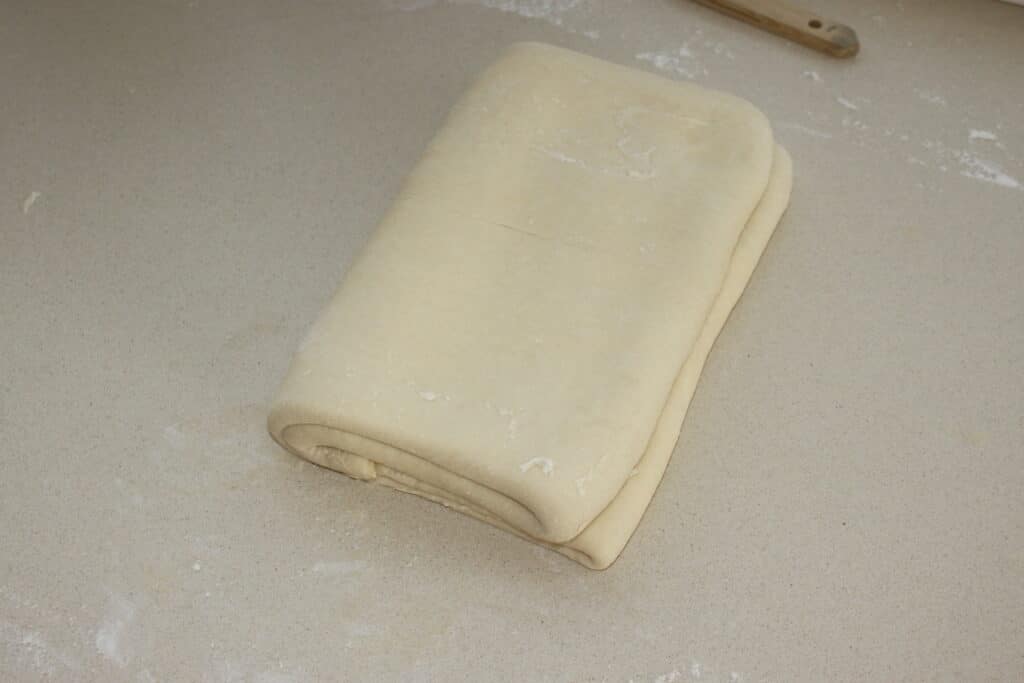
Let cool for 15 minutes. That’s all. Turn the dough 90° and roll out into a new rectangle.

Trim the ends and fold this time in thirds.

You can also incise the fold.

Roll out the dough this time into a 30x40cm rectangle. Trim the edges. You can now gather all the scraps together to push into a small pan and then bake. You will have a brioche, not very beautiful and less rich, but nevertheless delicious!

Cut the dough into 3 pieces.

Lay the three strips of dough on top of each other.

Then roll them up together.

Place in a greased baking pan. You can pull the top edge of each strip to slide them under the dough.
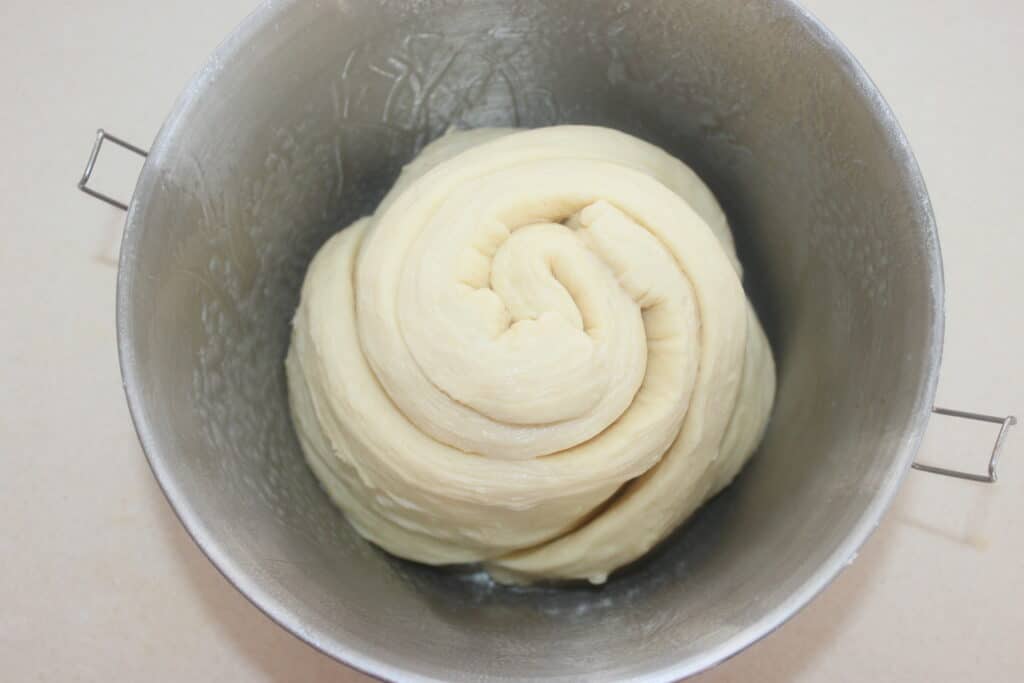
Let it grow for 1 to 1.5 hours so that it swells well. Brush the gold onto the smooth edges of the dough.

Bake for 1 hour and 10 minutes in a preheated oven at 150°C in rotating heat mode. As soon as the brioche comes out of the oven, brush syrup over the entire surface to make it shine.

To be enjoyed hot, warm or at room temperature. Delicious plain or with a good jam!


Puff pastry brioche
Ingredients
Dough:
- 500 g T55 flour
- 1 packet of dry baker's yeast (5g) or 15g of fresh yeast
- 75 g sugar
- 5 g salt
- 115 g egg
- 265 g milk
- 75 g soft butter
Then:
- 175 g soft butter with 82% fat content
Instructions
- Pour all the ingredients for the dough except the butter into the bowl of your food processor fitted with the hook.
- Mix for at least 10 minutes. The dough is very soft.
- Add the 75g of butter then mix again until it is perfectly incorporated.
- Put a film on the contact and let it grow one night in the refrigerator.
- The next day the dough is perfect and has grown well.
- This time take the 175g of 82% butter. Just look in the shelves, you will find it. It is often an AOP Charentes Poitou butter. Flour it.
- Leave it at room temperature for 5-10 minutes (unless it’s hot) then tap it with the rolling pin to soften it, without heating it. Shape it into a 16cm square. You can also put it in a 16cm frame for ease.
- Take the dough out of the fridge and flour it. Place it on the work surface and press it down to release the gas.
- Roll out the dough into a 32cm x 16cm rectangle. Place the butter (still fresh) in the center.
- Join the edges to cover the butter.
- Roll out the dough into a long rectangle with parallel edges.
- Trim the end for a clean edge. Keep the scraps.
- Fold the dough over to meet the two ends.
- Then fold in half again. You did a double turn.
- Let cool for 15 minutes. That’s all. Turn the dough 90° and roll out into a new rectangle.
- Trim the ends and fold this time in thirds.
- You can also incise the fold.
- Roll out the dough this time into a 30x40cm rectangle. Trim the edges. You can now gather all the scraps together to push into a small pan and then bake. You will have a brioche, not very beautiful and less rich, but nevertheless delicious!
- Cut the dough into 3 pieces.
- Lay the three strips of dough on top of each other.
- Then roll them up together.
- Place in a greased baking pan. You can pull the top edge of each strip to slide them under the dough.
- Let it grow for 1 to 1.5 hours so that it swells well. Brush the gold onto the smooth edges of the dough.
- Bake for 1 hour and 10 minutes in a preheated oven at 150°C in rotating heat mode. As soon as the brioche comes out of the oven, brush syrup over the entire surface to make it shine.
- To be enjoyed hot, warm or at room temperature. Delicious plain or with a good jam!

Voici ma recette que j’utilise et qui est une petite variante de la recette de Monsieur Conticini :
Brioche feuilletée qui se réalise en deux jours… Mais le Graal du p’tit dej.
Le premier jour :
Pour le sirop :
40 gr de sucre
40 gr d’eau
Pour la pâte :
510 gr de farine T 45 idéalement (mais aussi en T 55 éventuellement)
45 à 50 gr de sucre cristallisé normal
15 cl de lait entier légèrement tiède ( soit donc 1,5 dl… eh oui)
50 gr de beurre à T° ambiante coupé en petits morceaux
20 à 25 gr de levure fraiche
3 oeufs entiers et battus à T° ambiante
1 cuillère à café de sel fin
1 cuillère à café de bicarbonate de soude éventuellement
Quelques gouttes de vanille éventuellement
80 gr de sucre en grains + 20 gr de sucre fin pour rouler les pâte à la fin
Pour le tourage :
300 gr de beurre (idéalement « beurre de tourage » ou « beurre de Charente » ou « beurre sec à 84 %» de la marque « Président »… si vous en trouvez.) Moi, je l’ai fait avec du beurre normal la première fois…
Glaçage ou plus exactement « abricotage »… Très facile, facultatif, mais que je recommande quand même :
1/3 de confiture d’abricots (plutôt la gelée, pas de gros fruits entiers).
1/3 de miel d’acacia (miel neutre, clair et liquide)
1/3 de sucre de canne liquide (oui, oui : celui qu’on utilise dans les cocktails 😉
En petite quantité, que l’on fait tiédir au micro-ondes par exemple, et qu’on applique au pinceau sur la brioche, après la cuisson et après son refroidissement.
On donne ainsi de la brillance à la pâtisserie et une petite touche sucrée neutre bien agréable qui colle très bien aux doigt…
On y va… et on reprend le même travail que celui proposé ci-dessus…
Un régal votre brioche feuilletée! J’ai utilisé de la levure fraiche. Tout s’est très bien passé car vos explications avec photos sont très claires comme d’habitude. L’odeur pendant la cuisson et après était tellement alléchante que toute la famille attendait que la brioche refroidisse un peu pour déguster…. Si bien que je n’ai pas pensé à faire une photo :).
Je recommence très prochainement. Merci beaucoup de nous régaler toujours.
Pâte très élastique te collante au sortir du frigo, (trop de lait ?…) et pas levée. Quasi impossible à étaler. N’a pas cuit, est restée compacte et crue à l’intérieur. Problème de levure, êtes vous sûre de la quantité ? (un sachet fait 8g et pas 5) Ne devrait elle pas être diluée dans le lait tiède avant d’être incorporée au autre ingrédients comme ça se fait habituellement ? Au lieu d’une nuit au frigo, un temps plus court à température ambiante ne serait il pas mieux ? Bref raté.
Merci beaucoup pour la recette et les explications. J ai bien modifié la quantité de lait.Dommage que je ne puisse pas mettre une photo car en plus pour une première , elle est non seulement très bien au beau feuilletage mais très bonne.
Merci pour la recette et les explications. Très belle brioche .
Très belle recette. J’aimerais savoir si je voudrais faire de petite brioches, le temp de cuisson reste le même ou pas?
Cette brioche donne vraiment envie ! Je vais la tenter pour le week-end à venir ! J’ai reçu le livre “scandaleusement décadent” et il est tout simplement magnifique, les recettes avec les photos sont sublimes, il ne reste plus qu’à les tester. En tout cas entre le blog qui fourmille de renseignements et les livres que vous éditez, un grand merci pour ce partage et tout simplement bravo !
Bonjour, et merci pour votre site.
J’ai réalisé cette brioche qui était délicieuse ! Cependant dès la réalisation de la détrempe, j’ai dû changer les proportions et rajouter pas mal de farine. Le commentaire de Steph me conforte dans le sentiment qu’il y a une erreur dans les proportions (peut être 165cl de lait et pas 265?)
Mais sinon le top!
Bonjour Bernard et merci beaucoup pour cette recette ! Elle sera idéale pour ma première brioche feuilletée…je ne fais habituellement que des brioches “classiques”. J’ai entendu parler de Tang Zhong qui aiderait à obtenir une brioche (ou autres préparations de pâte levée) plus moelleuse et de plus longue garde. Un avis sur ce mélange ? A nouveau merci et belle journée
Bonsoir , il faut prendre un moule de quelle taille s’il vous plait? Cordialement
ST VAAST LA HOUGUE
Une spécialité de la ville du Cotentin : St Vaast la Fougue, j’en ai encore les papilles qui frissonnent. Je réaliserai cette recette en métropole car c’est incompatible avec le climat de la Guyane.
Je l’ai réalisée et c’est super bon!!
Même si elle ne va pas être aussi belle que la tienne, elle est entrain de pousser et après hop en cuisson !!
Magnifique ! Pour le moule, quelle taille est conseillée ? Merci
Mais quelle merveille cette brioche !!!
tout simplement mangifique cette brioche
échec total, la pâte sort du refregirateur complétement gluante, impossible à travailler!
farinez le plan de travail, farinez la pate, et travaillez là au rouleau jusqu’à incorporation de la farine, le côté “gluant” finira par disparaître. Vous pourrez ensuite passer au feuilletage.
Je ne sais pas pourquoi. Je vous donne mes recettes au gramme près, et je vous donne tous les secrets !
Effectivement la quantité de lait est trop importante et rend le façonnage très difficile on va voir ce que çà donne après la pousse et la cuisson.
Il me semble d’ailleurs que la quantité de lait dans la video est moins importante.
En tous cas merci pour les recettes j’adore celle des pasteis qui sont vraiment comme là bas!!!
Quelle vidéo ?
Elle doit être délicieuse , cette brioche ! juste une remarque : est-ce 75 grammes de beurre qu’il faut intégrer au pâton, comme indiqué sur la recette , ou 175 g indiqué dans la liste des ingrédients ? Merci de cette précision
Je vois que vous n’avez pas reçu de réponse apparement… Les 75 gr. vont dans la pâte avec les autres ingrédients qui se passe dans la cuve du robot et les 175 gr. sont utilisés le lendemain pour faire le feuilletage au rouleau proprement dit.
échec total, la pâte sort du refregirateur complétement gluante, impossible à travailler!
Effectivement la quantité de lait est trop importante et rend le façonnage très difficile on va voir ce que çà donne après la pousse et la cuisson.
Il me semble d’ailleurs que la quantité de lait dans la video est moins importante.
En tous cas merci pour les recettes j’adore celle des pasteis qui sont vraiment comme là bas!!!
Elle doit être délicieuse , cette brioche ! juste une remarque : est-ce 75 grammes de beurre qu’il faut intégrer au pâton, comme indiqué sur la recette , ou 175 g indiqué dans la liste des ingrédients ? Merci de cette précision